Answered step by step
Verified Expert Solution
Question
1 Approved Answer
Answer the follwing questions in detail. Minimum of ((two full pages.)) 1. Analyze the environment for the hair colour market in India fro CavinKare's perspective.
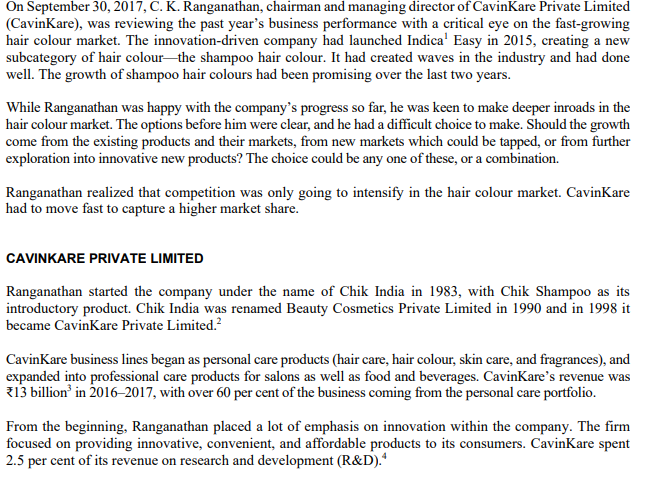
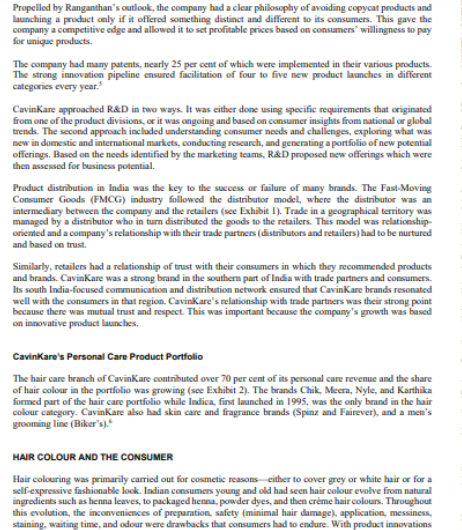
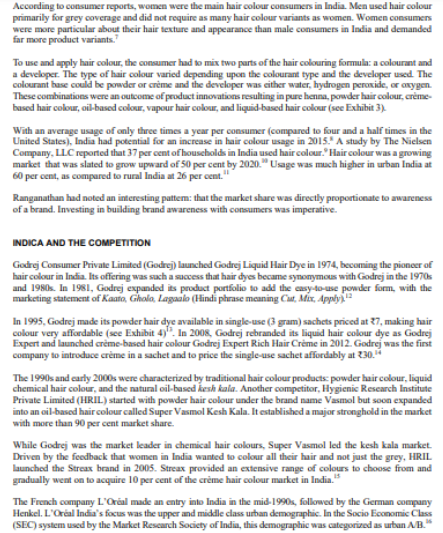
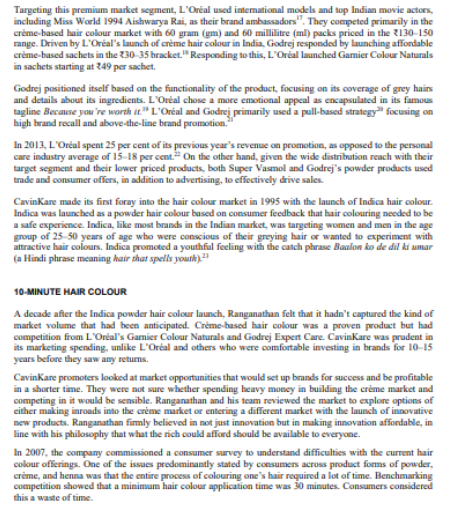
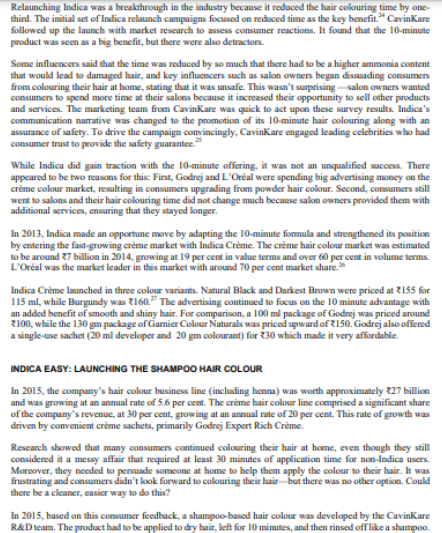
Answer the follwing questions in detail. Minimum of ((two full pages.))
1. Analyze the environment for the hair colour market in India fro CavinKare's perspective.
2. Describe the consumer behaviour in the hair colour market. How does it influence the approach toward new product development?
3. Critically evaluate CavinKare's approach to their market plan for Indica Easy.
4. What options for market growth is Ranganathan considering? What is the best choic and why?
On September 30, 2017, C. K. Ranganathan, chairman and managing director of CavinKare Private Limited (CavinKare), was reviewing the past year's business performance with a critical eye on the fast-growing hair colour market. The innovation-driven company had launched Indica' Easy in 2015, creating a new subcategory of hair colourthe shampoo hair colour. It had created waves in the industry and had done well. The growth of shampoo hair colours had been promising over the last two years. While Ranganathan was happy with the company's progress so far, he was keen to make deeper inroads in the hair colour market. The options before him were clear, and he had a difficult choice to make. Should the growth come from the existing products and their markets, from new markets which could be tapped, or from further exploration into innovative new products? The choice could be any one of these, or a combination. Ranganathan realized that competition was only going to intensify in the hair colour market. CavinKare had to move fast to capture a higher market share. CAVINKARE PRIVATE LIMITED Ranganathan started the company under the name of Chik India in 1983, with Chik Shampoo as its introductory product. Chik India was renamed Beauty Cosmetics Private Limited in 1990 and in 1998 it became CavinKare Private Limited.? CavinKare business lines began as personal care products (hair care, hair colour, skin care, and fragrances), and expanded into professional care products for salons as well as food and beverages. CavinKare's revenue was 313 billion in 2016-2017, with over 60 per cent of the business coming from the personal care portfolio. From the beginning, Ranganathan placed a lot of emphasis on innovation within the company. The firm focused on providing innovative, convenient, and affordable products to its consumers. CavinKare spent 2.5 per cent of its revenue on research and development (R&D). Propelled by Ranganthan's outlook, the company had a clear philosophy of avoiding copycat products and launching a product only if it offered something distinct and different to its consumers. This gave the company a competitive edge and allowed it to set profitable prices based on consumers willingness to pay for unique products. The company had many patents, nearly 25 per cent of which were implemented in their various products. The strong innovation pipeline ensured facilitation of four to five new product launches in different categories every year. CavinKare approached R&D in two ways. It was either done using specific requirements that originated from one of the product divisions, or it was ongoing and based on consumer insights from national or global trends. The second approach included understanding consumer needs and challenges, exploring what was new in domestic and international markets, conducting research, and generating a portfolio of new potential offerings. Based on the needs identified by the marketing teams, R&D proposed new offerings which were then assessed for business potential Product distribution in India was the key to the success or failure of many brands. The Fast-Moving Consumer Goods (FMCG) industry followed the distributor model, where the distributor was an intermediary between the company and the retailers (see Exhibit 1). Trade in a geographical territory was managed by a distributor who in turn distributed the goods to the retailers. This model was relationship oriented and a company's relationship with their trade partners (distributors and retailers) had to be nurtured and based on trust Similarly, retailers had a relationship of trust with their consumers in which they recommended products and brands. CavinKare was a strong brand in the southern part of India with trade partners and consumers. Its south India focused communication and distribution network ensured that CavinKare brands resonated well with the consumers in that region. CavinKare's relationship with trade partners was their strong point because there was mutual trust and respect. This was important because the company's growth was based on innovative product launches. CavinKare's Personal Care Product Portfolio The hair care branch of CavinKare contributed over 70 per cent of its personal care revenue and the share of hair colour in the portfolio was growing (see Exhibit 2). The brands Chik, Meera, Nyle, and Karthika formed part of the hair care portfolio while Indica, first launched in 1995, was the only brand in the hair colour category. CavinKare also had skin care and fragrance brands (Spanz and Fairever), and a men's grooming line (Biker's). HAIR COLOUR AND THE CONSUMER Hair colouring was primarily carried out for cosmetic reasons either to cover grey or white hair or for a self-expressive fashionable look. Indian consumers young and old had seen hair colour evolve from natural ingredients such as henna leaves, to packaged henna, powder dyes, and then creme hair colours. Throughout this evolution, the inconveniences of preparation, safety (minimal hair damage), application, messiness, staining, waiting time, and odour were drawbacks that consumers had to endure. With product innovations According to consumer reports, women were the main hair colour consumers in India. Men used hair colour primarily for grey coverage and did not require as many hair colour variants as women. Women consumers were more particular about their hair texture and appearance than male consumers in India and demanded far more product Variants. To use and apply hair colour, the consumer had to mix two parts of the hair colouring fomula: a colourant and a developer. The type of hair colour varied depending upon the colourant type and the developer used. The colourant base could be powder or creme and the developer was either water, hydrogen peroxide, or oxygen These combinations were an outcome of product innovations resulting in pure henna, powder hair colour, creme based hair colour, oil-based colour, vapeur hair colour, and liquid based hair colour (sce Exhibit 3) With an average usage of only three times a year per consumer (compared to four and a half times in the United States), India had potential for an increase in hair colour usage in 2015. A study by The Nielsen Company, LLC reported that 37 per cent of households in India used hair colour Hair colour was a growing market that was slated to grow upward of 50 per cent by 2020. Usage was much higher in urban India at 60 per cent, as compared to rural India at 26 per cent." Ranganathan had noted an interesting patter: that the market share was directly proportionate to awareness of a brand. Investing in building brand awareness with consumers was imperative INDICA AND THE COMPETITION Godrej Consumer Private Limited (Godrej) launched Godrej Liquid Hair Dye in 1974, becoming the pioneer of hair colour in India. Its offering was such a success that hair dyes became synonymous with Godrej in the 1970 and 1980s. In 1981, Godrej expanded its product portfolio to add the easy-to-use powder form, with the marketing statement of Kaato, Gholo. Lagaalo (Hindi phrase meaning Cut Mix, Appiya In 1995, Godrej made its powder hair dye available in single-use (3 gram) sachets priced at 27, making hair colour very affordable see Exhibit 4). In 2008, Godrej rebranded its liquid hair colour dye as Godrej Expert and launched creme-based hair colour Godrej Expert Rich Hair Creme in 2012.Godrej was the first company to introduce crme in a sachet and to price the single-use sachet affordably at 230. The 1990s and early 2000s were characterized by traditional hair colour products: powder hair colour, liquid chemical hair colour, and the natural oil-based kesh kala. Another competitor, Hygienic Research Institute Private Limited (HRIL) started with powder hair colour under the brand name Vasmol but soon expanded into an il-based hair colour called Super Vasmol Kesh Kala. It established a major stronghold in the market with more than 90 per cent market share. While Godrej was the market leader in chemical hair colours, Super Vasmol led the kesh kala market. Driven by the feedback that women in India wanted to colour all their hair and not just the grey, HRIL launched the Streas brand in 2005. Streax provided an extensive range of colours to choose from and gradually went on to acquire 10 per cent of the crme hair colour market in India." The French company L'Oreal made an entry into India in the mid-1990s, followed by the German company Henkel. L'Oral India's focus was the upper and middle class urban demographic in the Socio Economic Class (SEC) system used by the Market Research Society of India, this demographic was categorized as urban AB. Targeting this premium market segment, L'Oral used international models and top Indian movie actors, including Miss World 1994 Aishwarya Rai, as their brand ambassadors". They competed primarily in the crime-based hair colour market with 60 gram (gm) and 60 millilitre (ml) packs priced in the 2130-150 range. Driven by L'Oreal's launch of crme hair colour in India. Godrej responded by launching affordable crme bused sachets in the 230-35 bracket." Responding to this, L'Oral launched Gamier Colour Naturals in sachets starting at 349 per sachet. Godrej positioned itself based on the functionality of the product, focusing on its coverage of grey hairs and details about its ingredients. L'Oreal chose a more emotional appeal as encapsulated in its famous tagline Because you're worth it." L'Oreal and Godrej primarily used a pull-based strategy focusing on high brand recall and above-the-line brand promotion. In 2013. L'Oreal spent 25 per cent of its previous year's revenue on promotion, as opposed to the personal care industry average of 15-18 per cent. On the other hand, given the wide distribution reach with their target segment and their lower priced products, both Super Vasmol and Godrej's powder products used trade and consumer offers, in addition to advertising, to effectively drive sales CavinKare made its first foray into the hair colour market in 1995 with the launch of Indica hair colour. Indica was launched as a powder hair colour based on consumer feedback that hair colouring needed to be a safe experience. Indica, like most brands in the Indian market, was targeting women and men in the age group of 25-50 years of age who were conscious of their greying hair or wanted to experiment with attractive hair colours. Indica promoted a youthful feeling with the catchphrase Baslon kode dil ki mar (a Hindi phrase meaning hair that spells youth). 3 10-MINUTE HAIR COLOUR A decade after the Indica powder hair colour launch, Ranganathun felt that it hadn't captured the kind of market volume that had been anticipated. Creme-based hair colour was a proven product but had competition from L'Oral's Gamier Colour Naturals and Godrej Expert Care. CavinKare was prudent in its marketing spending, unlike L'Oral and others who were comfortable investing in brands for 10-15 years before they saw any retums. CavinKare promoters looked at market opportunities that would set up brands for success and be profitable in a shorter time. They were not sure whether spending heavy money in building the creme market and competing in it would be sensible. Ranganathan and his team reviewed the market to explore options of either making inroads into the crme market or entering a different market with the launch of innovative new products. Ranganathan fimmly helieved in not just innovation but in making innovation affordable, in line with his philosophy that what the rich could affoed should be available to everyone. In 2007, the company commissioned a consumer survey to understand difficulties with the current hair colour offerings. One of the issues predominantly stated by consumers across product forms of powder, creme, and henna was that the entire process of colouring one's hair required a lot of time. Benchmarking competition showed that a minimum hair colour application time was 30 minutes. Consumers considered this a waste of time. Relaunching Indica was a breakthrough in the industry because it reduced the hair colouring time by one- third. The initial set of Indica relaunch campaigns focused on reduced time as the key benefit CavinKare followed up the launch with market research to assess consumer reactions. It found that the 10-minute product was seen as a big benefit, but there were also detractors Some influencers said that the time was reduced by so much that there had to be a higher ammonia content that would lead to damaged hair, and key influencers such as salon owners began dissuading consumers from colouring their hair at home, stating that it was unsafe. This wasn't surprising salon owners wanted consumers to spend more time at their salons because it increased their opportunity to sell other products and services. The marketing team from CavinKare was quick to act upon these survey results. Indica's communication narrative was changed to the promotion of its 10-minute hair colouring along with an assurance of safety. To drive the campaign convincingly, CavinKare engaged leading celebrities who had consumer trust to provide the safety guarantee. While Indica did gain traction with the 10-minute offering, it was not an unqualified success. There appeared to be two reasons for this: First, Godrej and L'Oreal were spending big advertising money on the creme colour market, resulting in consumers upgrading from powder hair colour. Second, consumers still went to salons and their hair colouring time did not change much because salon owners provided them with additional services, ensuring that they stayed longer. In 2013, Indica made an opportune move by adapting the 10-minute formula and strengthened its position by entering the fast-growing crme market with Indica Creme. The crme hair colour market was estimated to be around 7 billion in 2014. growing at 19 per cent in value terms and over 60 per cent in volume terms. L'Oral was the market leader in this market with around 70 per cent market share. Indica Crme launched in three colour variants. Natural Black and Darkest Brown were priced at 2155 for 115 ml, while Burgundy was 2160." The advertising continued to focus on the 10 minute advantage with an added benefit of smooth and shiny hair. For comparison, a 100 ml package of Godrej was priced around 2100, while the 130 gm package of Gamier Colour Naturals was priced upward of 150. Godrej also offered a single-use sachet (20 ml developer and 20 gm colourant) for 230 which made it very affordable INDICA EASY: LAUNCHING THE SHAMPOO HAIR COLOUR In 2015, the company's hair colour business line (including henna) was worth approximately 227 billion and was growing at an annual rate of 5.6 per cent. The crme hair colour line comprised a significant share of the company's revenue, at 30 per cent growing at an annual rate of 20 per cent. This rate of growth was driven by convenient crme sachets, primarily Godrej Expert Rich Creme Research showed that many consumers continued colouring their hair at home, even though they still considered it a messy affair that required at least 30 minutes of application time for non-Indica users. Moreover, they needed to persuade someone at home to help them apply the colour to their hair. It was frustrating and consumers didn't look forward to colouring their hair but there was no other option. Could there be a cleaner, casier way to do this? In 2015, based on this consumer feedback, a shampoo-based hair colour was developed by the CavinKare R&D team. The product had to be applied to dry hair, left for 10 minutes, and then rinsed off like a shampoo On September 30, 2017, C. K. Ranganathan, chairman and managing director of CavinKare Private Limited (CavinKare), was reviewing the past year's business performance with a critical eye on the fast-growing hair colour market. The innovation-driven company had launched Indica' Easy in 2015, creating a new subcategory of hair colourthe shampoo hair colour. It had created waves in the industry and had done well. The growth of shampoo hair colours had been promising over the last two years. While Ranganathan was happy with the company's progress so far, he was keen to make deeper inroads in the hair colour market. The options before him were clear, and he had a difficult choice to make. Should the growth come from the existing products and their markets, from new markets which could be tapped, or from further exploration into innovative new products? The choice could be any one of these, or a combination. Ranganathan realized that competition was only going to intensify in the hair colour market. CavinKare had to move fast to capture a higher market share. CAVINKARE PRIVATE LIMITED Ranganathan started the company under the name of Chik India in 1983, with Chik Shampoo as its introductory product. Chik India was renamed Beauty Cosmetics Private Limited in 1990 and in 1998 it became CavinKare Private Limited.? CavinKare business lines began as personal care products (hair care, hair colour, skin care, and fragrances), and expanded into professional care products for salons as well as food and beverages. CavinKare's revenue was 313 billion in 2016-2017, with over 60 per cent of the business coming from the personal care portfolio. From the beginning, Ranganathan placed a lot of emphasis on innovation within the company. The firm focused on providing innovative, convenient, and affordable products to its consumers. CavinKare spent 2.5 per cent of its revenue on research and development (R&D). Propelled by Ranganthan's outlook, the company had a clear philosophy of avoiding copycat products and launching a product only if it offered something distinct and different to its consumers. This gave the company a competitive edge and allowed it to set profitable prices based on consumers willingness to pay for unique products. The company had many patents, nearly 25 per cent of which were implemented in their various products. The strong innovation pipeline ensured facilitation of four to five new product launches in different categories every year. CavinKare approached R&D in two ways. It was either done using specific requirements that originated from one of the product divisions, or it was ongoing and based on consumer insights from national or global trends. The second approach included understanding consumer needs and challenges, exploring what was new in domestic and international markets, conducting research, and generating a portfolio of new potential offerings. Based on the needs identified by the marketing teams, R&D proposed new offerings which were then assessed for business potential Product distribution in India was the key to the success or failure of many brands. The Fast-Moving Consumer Goods (FMCG) industry followed the distributor model, where the distributor was an intermediary between the company and the retailers (see Exhibit 1). Trade in a geographical territory was managed by a distributor who in turn distributed the goods to the retailers. This model was relationship oriented and a company's relationship with their trade partners (distributors and retailers) had to be nurtured and based on trust Similarly, retailers had a relationship of trust with their consumers in which they recommended products and brands. CavinKare was a strong brand in the southern part of India with trade partners and consumers. Its south India focused communication and distribution network ensured that CavinKare brands resonated well with the consumers in that region. CavinKare's relationship with trade partners was their strong point because there was mutual trust and respect. This was important because the company's growth was based on innovative product launches. CavinKare's Personal Care Product Portfolio The hair care branch of CavinKare contributed over 70 per cent of its personal care revenue and the share of hair colour in the portfolio was growing (see Exhibit 2). The brands Chik, Meera, Nyle, and Karthika formed part of the hair care portfolio while Indica, first launched in 1995, was the only brand in the hair colour category. CavinKare also had skin care and fragrance brands (Spanz and Fairever), and a men's grooming line (Biker's). HAIR COLOUR AND THE CONSUMER Hair colouring was primarily carried out for cosmetic reasons either to cover grey or white hair or for a self-expressive fashionable look. Indian consumers young and old had seen hair colour evolve from natural ingredients such as henna leaves, to packaged henna, powder dyes, and then creme hair colours. Throughout this evolution, the inconveniences of preparation, safety (minimal hair damage), application, messiness, staining, waiting time, and odour were drawbacks that consumers had to endure. With product innovations According to consumer reports, women were the main hair colour consumers in India. Men used hair colour primarily for grey coverage and did not require as many hair colour variants as women. Women consumers were more particular about their hair texture and appearance than male consumers in India and demanded far more product Variants. To use and apply hair colour, the consumer had to mix two parts of the hair colouring fomula: a colourant and a developer. The type of hair colour varied depending upon the colourant type and the developer used. The colourant base could be powder or creme and the developer was either water, hydrogen peroxide, or oxygen These combinations were an outcome of product innovations resulting in pure henna, powder hair colour, creme based hair colour, oil-based colour, vapeur hair colour, and liquid based hair colour (sce Exhibit 3) With an average usage of only three times a year per consumer (compared to four and a half times in the United States), India had potential for an increase in hair colour usage in 2015. A study by The Nielsen Company, LLC reported that 37 per cent of households in India used hair colour Hair colour was a growing market that was slated to grow upward of 50 per cent by 2020. Usage was much higher in urban India at 60 per cent, as compared to rural India at 26 per cent." Ranganathan had noted an interesting patter: that the market share was directly proportionate to awareness of a brand. Investing in building brand awareness with consumers was imperative INDICA AND THE COMPETITION Godrej Consumer Private Limited (Godrej) launched Godrej Liquid Hair Dye in 1974, becoming the pioneer of hair colour in India. Its offering was such a success that hair dyes became synonymous with Godrej in the 1970 and 1980s. In 1981, Godrej expanded its product portfolio to add the easy-to-use powder form, with the marketing statement of Kaato, Gholo. Lagaalo (Hindi phrase meaning Cut Mix, Appiya In 1995, Godrej made its powder hair dye available in single-use (3 gram) sachets priced at 27, making hair colour very affordable see Exhibit 4). In 2008, Godrej rebranded its liquid hair colour dye as Godrej Expert and launched creme-based hair colour Godrej Expert Rich Hair Creme in 2012.Godrej was the first company to introduce crme in a sachet and to price the single-use sachet affordably at 230. The 1990s and early 2000s were characterized by traditional hair colour products: powder hair colour, liquid chemical hair colour, and the natural oil-based kesh kala. Another competitor, Hygienic Research Institute Private Limited (HRIL) started with powder hair colour under the brand name Vasmol but soon expanded into an il-based hair colour called Super Vasmol Kesh Kala. It established a major stronghold in the market with more than 90 per cent market share. While Godrej was the market leader in chemical hair colours, Super Vasmol led the kesh kala market. Driven by the feedback that women in India wanted to colour all their hair and not just the grey, HRIL launched the Streas brand in 2005. Streax provided an extensive range of colours to choose from and gradually went on to acquire 10 per cent of the crme hair colour market in India." The French company L'Oreal made an entry into India in the mid-1990s, followed by the German company Henkel. L'Oral India's focus was the upper and middle class urban demographic in the Socio Economic Class (SEC) system used by the Market Research Society of India, this demographic was categorized as urban AB. Targeting this premium market segment, L'Oral used international models and top Indian movie actors, including Miss World 1994 Aishwarya Rai, as their brand ambassadors". They competed primarily in the crime-based hair colour market with 60 gram (gm) and 60 millilitre (ml) packs priced in the 2130-150 range. Driven by L'Oreal's launch of crme hair colour in India. Godrej responded by launching affordable crme bused sachets in the 230-35 bracket." Responding to this, L'Oral launched Gamier Colour Naturals in sachets starting at 349 per sachet. Godrej positioned itself based on the functionality of the product, focusing on its coverage of grey hairs and details about its ingredients. L'Oreal chose a more emotional appeal as encapsulated in its famous tagline Because you're worth it." L'Oreal and Godrej primarily used a pull-based strategy focusing on high brand recall and above-the-line brand promotion. In 2013. L'Oreal spent 25 per cent of its previous year's revenue on promotion, as opposed to the personal care industry average of 15-18 per cent. On the other hand, given the wide distribution reach with their target segment and their lower priced products, both Super Vasmol and Godrej's powder products used trade and consumer offers, in addition to advertising, to effectively drive sales CavinKare made its first foray into the hair colour market in 1995 with the launch of Indica hair colour. Indica was launched as a powder hair colour based on consumer feedback that hair colouring needed to be a safe experience. Indica, like most brands in the Indian market, was targeting women and men in the age group of 25-50 years of age who were conscious of their greying hair or wanted to experiment with attractive hair colours. Indica promoted a youthful feeling with the catchphrase Baslon kode dil ki mar (a Hindi phrase meaning hair that spells youth). 3 10-MINUTE HAIR COLOUR A decade after the Indica powder hair colour launch, Ranganathun felt that it hadn't captured the kind of market volume that had been anticipated. Creme-based hair colour was a proven product but had competition from L'Oral's Gamier Colour Naturals and Godrej Expert Care. CavinKare was prudent in its marketing spending, unlike L'Oral and others who were comfortable investing in brands for 10-15 years before they saw any retums. CavinKare promoters looked at market opportunities that would set up brands for success and be profitable in a shorter time. They were not sure whether spending heavy money in building the creme market and competing in it would be sensible. Ranganathan and his team reviewed the market to explore options of either making inroads into the crme market or entering a different market with the launch of innovative new products. Ranganathan fimmly helieved in not just innovation but in making innovation affordable, in line with his philosophy that what the rich could affoed should be available to everyone. In 2007, the company commissioned a consumer survey to understand difficulties with the current hair colour offerings. One of the issues predominantly stated by consumers across product forms of powder, creme, and henna was that the entire process of colouring one's hair required a lot of time. Benchmarking competition showed that a minimum hair colour application time was 30 minutes. Consumers considered this a waste of time. Relaunching Indica was a breakthrough in the industry because it reduced the hair colouring time by one- third. The initial set of Indica relaunch campaigns focused on reduced time as the key benefit CavinKare followed up the launch with market research to assess consumer reactions. It found that the 10-minute product was seen as a big benefit, but there were also detractors Some influencers said that the time was reduced by so much that there had to be a higher ammonia content that would lead to damaged hair, and key influencers such as salon owners began dissuading consumers from colouring their hair at home, stating that it was unsafe. This wasn't surprising salon owners wanted consumers to spend more time at their salons because it increased their opportunity to sell other products and services. The marketing team from CavinKare was quick to act upon these survey results. Indica's communication narrative was changed to the promotion of its 10-minute hair colouring along with an assurance of safety. To drive the campaign convincingly, CavinKare engaged leading celebrities who had consumer trust to provide the safety guarantee. While Indica did gain traction with the 10-minute offering, it was not an unqualified success. There appeared to be two reasons for this: First, Godrej and L'Oreal were spending big advertising money on the creme colour market, resulting in consumers upgrading from powder hair colour. Second, consumers still went to salons and their hair colouring time did not change much because salon owners provided them with additional services, ensuring that they stayed longer. In 2013, Indica made an opportune move by adapting the 10-minute formula and strengthened its position by entering the fast-growing crme market with Indica Creme. The crme hair colour market was estimated to be around 7 billion in 2014. growing at 19 per cent in value terms and over 60 per cent in volume terms. L'Oral was the market leader in this market with around 70 per cent market share. Indica Crme launched in three colour variants. Natural Black and Darkest Brown were priced at 2155 for 115 ml, while Burgundy was 2160." The advertising continued to focus on the 10 minute advantage with an added benefit of smooth and shiny hair. For comparison, a 100 ml package of Godrej was priced around 2100, while the 130 gm package of Gamier Colour Naturals was priced upward of 150. Godrej also offered a single-use sachet (20 ml developer and 20 gm colourant) for 230 which made it very affordable INDICA EASY: LAUNCHING THE SHAMPOO HAIR COLOUR In 2015, the company's hair colour business line (including henna) was worth approximately 227 billion and was growing at an annual rate of 5.6 per cent. The crme hair colour line comprised a significant share of the company's revenue, at 30 per cent growing at an annual rate of 20 per cent. This rate of growth was driven by convenient crme sachets, primarily Godrej Expert Rich Creme Research showed that many consumers continued colouring their hair at home, even though they still considered it a messy affair that required at least 30 minutes of application time for non-Indica users. Moreover, they needed to persuade someone at home to help them apply the colour to their hair. It was frustrating and consumers didn't look forward to colouring their hair but there was no other option. Could there be a cleaner, casier way to do this? In 2015, based on this consumer feedback, a shampoo-based hair colour was developed by the CavinKare R&D team. The product had to be applied to dry hair, left for 10 minutes, and then rinsed off like a shampooStep by Step Solution
There are 3 Steps involved in it
Step: 1

Get Instant Access to Expert-Tailored Solutions
See step-by-step solutions with expert insights and AI powered tools for academic success
Step: 2

Step: 3

Ace Your Homework with AI
Get the answers you need in no time with our AI-driven, step-by-step assistance
Get Started


